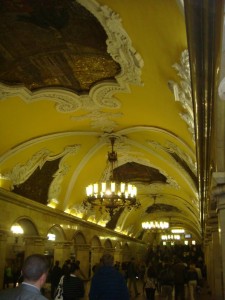
‘I’ve noticed something,’ says my brother as we wait for the subway in one of Moscow’s sumptuously decorated stations (above). We don’t have to wait long, as it runs on roughly 90 second intervals. I look at my brother, who is obviously trying to put a complex thought into words. ‘It’s the women in Moscow,’ he says. ‘They’re all beautiful.’
Unlike my brother, I don’t have to be a gentleman, and so I can say with impunity that the women in Moscow are not beautiful but gorgeous, smoldering, melt-the-resolve-of-a-priest hot. They have the kind of bodies that I latterly thought existed only on the pages of Maxim magazine. How Russian men function I cannot imagine: every straight American male I know would be unable to tear himself away from the continuous beauty pageant that is the street.
‘But there’s something else,’ says my brother, bringing me out of my reverie. ‘They dress themselves so well and do their hair and makeup – they’re undeniably trying to get people to look at them. Then when you catch their eye they give you this look of utter scorn, even disgust. It’s the same with the women in New York, who, by the way, are the only women I’ve seen who might even compare to the women here. It’s incredibly frustrating.’
I try to argue that women make themselves look beautiful for their own sake, because it makes them feel individual, superior perhaps… and then I realize I’m confirming my brother’s point. I’m good at confounding my own arguments, which means my decision not to go to law school is probably a good one.
[For an abrupt change of topic with stretched segue] The women in Moscow aren’t the only beautiful thing in town. The city could never be confused with one of those jewels like Paris or Venice where every facade deserves its own postcard, but it packs a punch of its own. There’s the vast imperial complex of the Kremlin, where even the J.Crew-watermelon-and-green bell towers look macho; the stunning ‘Seven Sisters,’ skyscrapers erected by Stalin, which defy all the negative stereotypes of Soviet architecture; the gold onion domes of the Church of Christ the Savior, gloriously reconstructed in 1997, (more on that in a second); the too-big-to-be-ridiculous statue of Peter the Great: in sum, enough evidence that this is one of the mightiest nations in history to earn respect from even the snobbiest Europhile.
The Cathedral of Christ the Savior was torn down by Stalin in 1931 (photo courtesy of wikipedia) to make way for a monument to socialism, to be known as the Palace of the Soviets. After the demolition of the 19th century masterpiece, rather bashful structural engineers informed Stalin that the riverside location would not support the weight of the planned palace, so Stalin had the site turned into a swimming pool instead. This seems to have been a popular way to repurpose those pesky religious buildings: I visited another church that had been reclaimed from swimming pool status a few days later. The tile floors and stadium-style seating centered on the altar were a surreal combination for me, as I spent all of my extracurricular time growing up in either a swimming pool or a church. It seemed like deliberately little effort was spent trying to make the place look like a church again, which made the place almost more holy: wherever two or three are gathered together, right?
